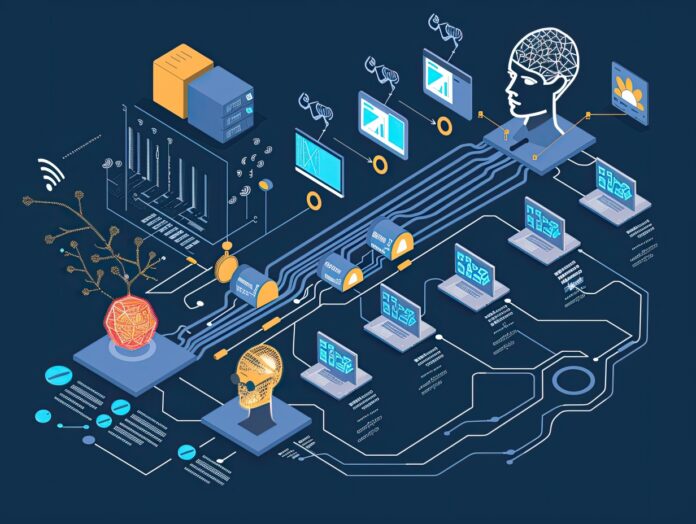Introduction to Deep Learning
Deep Learning (DL) is a subset of machine learning (ML) and artificial intelligence (AI) that focuses on algorithms inspired by the structure and function of the brain, known as artificial neural networks. These networks attempt to simulate the workings of the human brain in processing data and creating patterns for use in decision making. This post will introduce the fundamental concepts of deep learning, its significance, key techniques, and real-world applications, setting the stage for more detailed discussions on this transformative technology.
What is Deep Learning?
Deep learning involves training artificial neural networks with many layers, hence the term “deep.” These neural networks can automatically learn features from data, enabling them to perform tasks such as image and speech recognition, natural language processing, and more. Unlike traditional machine learning, deep learning requires less manual feature engineering, as the neural networks can automatically discover the representations needed for classification or detection.
Key Concepts in Deep Learning
- Neural Networks: The foundation of deep learning is the neural network, a series of algorithms that attempt to recognize underlying relationships in a set of data through a process that mimics the way the human brain operates. A neural network consists of input layers, hidden layers, and output layers.
- Layers: Layers are the building blocks of a neural network. Each layer consists of nodes (neurons) that receive input from the previous layer, process it, and pass the output to the next layer. Deep neural networks have multiple hidden layers that enable them to learn complex patterns in data.
- Activation Functions: Activation functions determine whether a neuron should be activated or not. They introduce non-linearity into the network, allowing it to learn complex patterns. Common activation functions include ReLU (Rectified Linear Unit), sigmoid, and tanh.
- Backpropagation: Backpropagation is the learning algorithm used to train neural networks. It involves adjusting the weights of the neurons based on the error of the output compared to the expected result. This process is repeated until the network produces accurate predictions.
- Training and Validation: Training a deep learning model involves feeding it large amounts of data and allowing it to learn from that data. The model is then validated on a separate dataset to ensure it generalizes well to new, unseen data.
Significance of Deep Learning
Deep learning has become a cornerstone of AI due to its ability to automatically learn complex patterns and representations from large amounts of data. Its significance can be summarized in several key areas:
- Accuracy: Deep learning models often achieve higher accuracy than traditional machine learning models, especially in tasks involving large and complex datasets, such as image and speech recognition.
- Automation: Deep learning reduces the need for manual feature engineering, as the neural networks can automatically discover relevant features from the raw data. This makes it easier to build and deploy AI models.
- Scalability: Deep learning models can scale to handle vast amounts of data and complex tasks. With advancements in computing power and cloud technologies, training deep learning models has become more feasible.
- Innovation: Deep learning has driven significant innovations across various industries, enabling the development of new technologies and applications that were previously not possible.

Key Deep Learning Techniques
- Convolutional Neural Networks (CNNs): CNNs are specialized neural networks designed for processing structured grid data, such as images. They use convolutional layers to automatically learn spatial hierarchies of features, making them highly effective for image recognition tasks.
- Recurrent Neural Networks (RNNs): RNNs are designed for sequential data, such as time series or text. They have loops that allow information to persist, making them suitable for tasks like language modeling and machine translation.
- Long Short-Term Memory (LSTM): LSTM is a type of RNN that addresses the vanishing gradient problem, enabling the network to learn long-term dependencies. LSTMs are widely used in tasks that require understanding context over long sequences, such as speech recognition and text generation.
- Generative Adversarial Networks (GANs): GANs consist of two neural networks, a generator and a discriminator, that compete against each other. The generator creates synthetic data, while the discriminator evaluates its authenticity. GANs are used for generating realistic images, videos, and other data.
- Autoencoders: Autoencoders are neural networks used for unsupervised learning. They learn to compress and then reconstruct data, capturing its essential features. Autoencoders are used for tasks like anomaly detection and data denoising.
Applications of Deep Learning
Deep learning has a wide range of applications across various industries. Some notable examples include:
- Healthcare: Deep learning is used for medical image analysis, disease diagnosis, and drug discovery. For instance, CNNs can analyze radiology images to detect abnormalities, while RNNs can analyze patient records to predict health outcomes.
- Finance: In the financial sector, deep learning algorithms are used for fraud detection, algorithmic trading, and risk management. These models analyze large volumes of transaction data to identify patterns and anomalies.
- Autonomous Vehicles: Deep learning is a core technology behind self-driving cars. CNNs process camera feeds to recognize objects and road signs, while RNNs manage the vehicle’s navigation and control systems.
- Natural Language Processing (NLP): Deep learning models are used for language translation, sentiment analysis, and chatbots. Models like Transformers and BERT have revolutionized NLP by enabling more accurate understanding and generation of human language.
- Entertainment: Streaming services like Netflix and Spotify use deep learning for content recommendation. These models analyze user preferences and behavior to suggest movies, TV shows, and music.
- Retail: Retailers use deep learning for inventory management, customer segmentation, and personalized marketing. Deep learning models help predict demand, optimize stock levels, and tailor marketing strategies to individual customers.
Challenges in Deep Learning
Despite its transformative potential, deep learning faces several challenges that need to be addressed:
- Data Requirements: Deep learning models require large amounts of data to train effectively. Acquiring and preprocessing this data can be resource-intensive.
- Computational Power: Training deep learning models is computationally expensive and requires powerful hardware, such as GPUs. This can be a barrier for smaller organizations.
- Interpretability: Deep learning models, especially those with many layers, can be difficult to interpret. Understanding how the model makes decisions is crucial for trust and accountability.
- Overfitting: Deep learning models can sometimes learn patterns specific to the training data, leading to poor generalization on new data. Techniques like regularization and dropout are used to mitigate this issue.
- Ethical Considerations: As with all AI technologies, deep learning raises ethical concerns, such as bias, privacy, and the potential for misuse. Addressing these concerns is essential for responsible AI development.
Future of Deep Learning
The future of deep learning is incredibly promising, with ongoing advancements expected to drive further innovation. Key trends to watch include:
- Transfer Learning: Transfer learning involves taking a pre-trained model on one task and fine-tuning it for a different but related task. This approach can significantly reduce the data and computational requirements for training new models.
- Edge Computing: Bringing deep learning to edge devices, such as smartphones and IoT devices, enables real-time data processing and decision-making. This reduces latency and enhances privacy by keeping data local.
- Federated Learning: Federated learning allows models to be trained across multiple decentralized devices without sharing raw data. This approach enhances privacy and security while leveraging data from diverse sources.
- Quantum Deep Learning: The integration of quantum computing with deep learning has the potential to solve complex problems faster than classical computers. This emerging field is expected to revolutionize industries with its computational power.
- Explainable AI: Developing techniques to make deep learning models more interpretable and transparent is an ongoing research area. Explainable AI aims to provide insights into how models make decisions, enhancing trust and accountability.
Conclusion
Deep learning is a powerful and transformative technology that has the potential to revolutionize various industries. Understanding its principles, techniques, and applications is essential for leveraging its full potential. As we continue to explore this fascinating field, staying informed about the latest developments and addressing emerging challenges will be key to harnessing the power of deep learning responsibly.
Useful Links:
- Deep Learning Specialization by Andrew Ng on Coursera
- Deep Learning Course by MIT
- Deep Learning for Beginners by Kaggle



